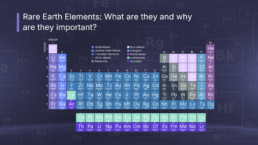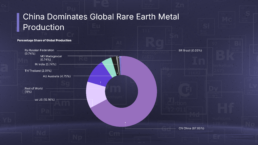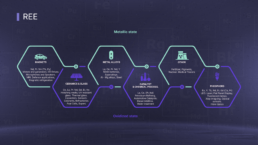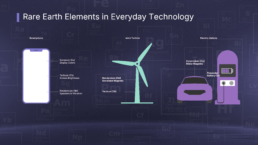The smartphone in your pocket harbors a secret that’s reshaping global politics and international trade. Within its sleek exterior lies a complex mixture of rare earth elements (REEs) – 17 metallic elements that have become the backbone of modern technology. However, finding economically viable deposits and processing them safely presents a significant challenge.
Rare Earth Elements: What are they and why are they important?
Rare earth elements (REEs) are known for their unique magnetic, luminescent, and electrochemical properties. They play a critical role in advanced technologies, from smartphones, electric vehicle batteries, and wind turbines to defense systems like guided missiles and communication systems like the satellites orbiting the earth. Despite the name, the elements are relatively abundant but rarely found in high concentrations, making extraction and refinement complex and environmentally taxing. For instance, a single offshore wind turbine requires about 600 kilograms of rare earth elements, while the global transition to electric vehicles is expected to double rare earth demand by 2030.
Rare earth elements (REEs) have become the invisible force driving modern technological advancement, much like how oil powered the industrial revolution. This makes REEs highly coveted by countries the world over. However, contentious issues arise because a single country – China – controls the majority of their production and supply chain, creating a global technology crisis driven by:
- Rapidly increasing demand driven by green technology adoption and digitalization
- Extremely concentrated supply chains with China controlling over 90% of global processing capacity
- Growing geopolitical tensions affecting trade relationships
A Brief History of Rare Earth Dominance
China’s dominance in rare earth elements (REEs) is due to a combination of factors:
Abundant Reserves: China holds some of the world’s largest deposits of REEs, particularly in Inner Mongolia’s Bayan Obo mine, one of the richest sources globally.
- Early Investment: Starting in the 1980s, China recognized the strategic importance of rare earths and heavily invested in mining and processing technologies while other countries, particularly the U.S., reduced their focus on the industry.
- Refinement Capabilities: Mining REEs is relatively straightforward, but refining and separating them is a complex, costly, and environmentally hazardous process. China developed advanced refining capacity and lowered costs by scaling operations and tolerating higher environmental impacts.
- Environmental and Cost Considerations: Stricter environmental regulations and higher labor costs in Western countries made REE production less economically viable, allowing China to dominate the market.
- Government Support: China’s state-backed companies benefit from subsidies, research investments, and favorable policies, further consolidating its grip on the market.
- Export Controls: By restricting exports of refined REEs in the past, China has leveraged its dominance as a geopolitical tool, underscoring the strategic importance of these critical resources.
“The Middle East has oil, China has rare earths.” This 1992 declaration by Deng Xiaoping (ex paramount leader of the People’s Republic of China) wasn’t just a statement – it was a manifesto. Throughout the 1990s and early 2000s, China’s strategy became clear through actions like the 1995 acquisition of Magnequench, a General Motors subsidiary that produced rare earth magnets for precision-guided missiles. This acquisition, coupled with aggressive pricing strategies, effectively transferred crucial technology and market share to China.
By 2010, China demonstrated its market power by restricting rare earth exports during a diplomatic dispute with Japan over the Senkaku Islands. The incident in question happened on 7 September 2010, when a Chinese fishing boat collided with two Japanese coast guard vessels off the islands of Senkaku in the East China Sea. The coastguard’s arrest of the fishing boat’s captain prompted a strong response from the Chinese government, which included halting rare earth mineral exports to Japan. Subsequently, the prices of rare earths soared close to 10x over the course of a year. The price of neodymium oxide surged from $42 per kilogram to $334 per kilogram, sending shockwaves through global technology markets. Today, China’s control of 60% of global mining operations, 90% of processing, and 92% of magnet production gives it unprecedented leverage in global technology markets.
India’s Position and Future Prospects in the Global REE Landscape
India’s engagement with rare earth elements dates back to the 1950s, when the Department of Atomic Energy established Indian Rare Earths Limited (IREL). While the country possesses approximately 6% of the world’s rare earth reserves, its current production of only 1% of global supply reflects historical underinvestment in this sector. However, recent geopolitical developments have catalyzed significant changes in India’s approach.
Strategic Initiatives and International Partnerships
India’s response to the global rare earth crisis has been multifaceted. The 2023 Critical Minerals Strategy outlined several ambitious initiatives, including:
The government launched a comprehensive program to revitalize the rare earth sector, with new mining sites in Kerala, Tamil Nadu, and Odisha. A significant breakthrough came in 2024 with the announcement of a $500 million investment in advanced processing facilities, developed in partnership with Japan’s JOGMEC. The formation of the India-Australia Critical Minerals Investment Partnership in 2023 provided a framework for technology transfer and joint development of processing capabilities.
Future Opportunities and Challenges
India’s position in the rare earth sector presents unique opportunities shaped by global events. The country’s strong technology sector, coupled with initiatives like “Make in India” and the Production Linked Incentive (PLI) scheme, creates potential for developing downstream industries. The establishment of the International Clean Energy Partnership in 2024, involving India, Japan, and Australia, specifically focuses on rare earth supply chains for renewable energy technologies.
However, challenges remain. Competition from established players like Australia’s Lynas Corporation and emerging producers in Africa requires India to move quickly. Environmental concerns, particularly regarding the processing of monazite sand due to its thorium content, need careful attention.
Critical Applications
The importance of rare earth elements extends far beyond consumer electronics, intersecting with major global trends and geopolitical tensions:
Modern Electronics and Communications
The global semiconductor shortage of 2021-2022 highlighted the vulnerability of technology supply chains. A single iPhone requires multiple rare earth elements, including neodymium for its speakers, europium and terbium for the display, and several others for various components. The worldwide deployment of 5G networks has further increased demand, as base stations require significant amounts of rare earth elements for their powerful magnets. The 2023 telecommunications infrastructure expansion in Southeast Asia alone created a 15% spike in global demand for certain rare earth elements.
Green Technology Revolution
The global push for renewable energy, accelerated by climate agreements and national policies, has dramatically increased REE demand. The European Union’s Green Deal aims to install 300 GW of offshore wind capacity by 2050, requiring approximately 180,000 metric tons of rare earth elements – nearly twice the current global annual production. The rapid growth of electric vehicle markets, particularly in China and Europe, has created additional pressure. Tesla’s decision to shift some vehicle models to rare earth-free motors in 2023 demonstrated both the urgency of supply concerns and the potential for technological adaptation.
Defense and Military Systems
Modern military capabilities increasingly depend on rare earth elements, creating national security concerns. The F-35 fighter jet program, involving multiple nations and requiring 920 pounds of rare earth materials per aircraft, exemplifies this dependency. The 2024 defense cooperation agreement between Japan and the Philippines, partly motivated by concerns over rare earth access and regional security, shows how REE supply chains influence military alliances.
The 2024 Crisis: Geopolitical Tension, Export Controls and Global Impact
China’s implementation of export restrictions in 2024, coinciding with restrictions on semiconductor exports, represented a strategic response to Western efforts to limit China’s access to advanced technology. These controls triggered a cascade of effects though global markets. Manufacturing costs soared, production schedules for everything from smartphones to fighter jets faced disruptions, and alternative supply chains proved inadequate to meet global demand.
Manufacturing costs for electric vehicles increased by up to 25%, forcing companies like Volkswagen and Ford to raise prices. Several major technology companies, including Samsung and Apple, delayed product launches due to supply chain disruptions. Defense contractors in NATO countries reported significant challenges in maintaining production schedules. The price of dysprosium oxide, crucial for permanent magnets, surged by 240% within three months of the announcement. The crisis has catalyzed unprecedented international cooperation and innovation:
Government Initiatives
The United States’ CHIPS (Creating Helpful Incentives to Produce Semiconductors) and Science Act of 2022 included $2 billion in funding for rare earth research and development. The European Raw Materials Act of 2023 set specific targets for reducing dependency on foreign rare earth supplies, aiming for 30% domestic production by 2030. Japan’s partnership with Vietnam to develop rare earth mining and processing capabilities demonstrates the emergence of new regional alignments.
Corporate Innovation
Companies are actively pursuing alternative technologies. Toyota’s announcement of new motor designs using reduced amounts of rare earth elements marked a significant breakthrough in 2024. Apple’s investment in recycling technologies through its Daisy robot system has shown promising results, recovering up to 20% of rare earth elements from recycled devices. The emergence of new mining projects in Greenland and Canada, backed by international consortiums, suggests a reshaping of global supply chains.
Environmental Considerations and Sustainable Solutions
The environmental impact of rare earth mining and processing presents significant challenges. Traditional extraction methods often produce hazardous waste and consume large amounts of water.
The urgent need to diversify rare earth element production while minimizing environmental impact has sparked a wave of technological innovation across the industry. Scientists and engineers are developing groundbreaking approaches that promise to transform how we extract, process, and recycle these crucial materials.
Novel Extraction Technologies
A revolutionary breakthrough came in 2024 when researchers at the Massachusetts Institute of Technology developed a new electrochemical separation process that can extract rare earth elements from ore using 40% less energy than traditional methods. Meanwhile, Australian scientists have pioneered a technique using carbon dioxide in a supercritical state to dissolve and separate rare earth elements, eliminating the need for harsh chemicals traditionally used in processing.
Biological Innovation
Bio-mining has emerged as a promising environmentally friendly alternative. Companies like Bio-Mine Ltd. have developed specialized bacteria strains that can selectively extract rare earth elements from ore through biosorption. This process not only reduces environmental impact but also achieves extraction rates comparable to traditional methods. In Japan, researchers have successfully used engineered proteins to separate and purify rare earth elements with unprecedented precision.
Advanced Recycling and Urban Mining
The concept of “urban mining” – recovering rare earth elements from electronic waste – has seen significant technological advancement. A breakthrough process developed by Belgian researchers can now recover up to 90% of rare earth elements from old smartphones and computers. Apple’s Daisy recycling system, enhanced with artificial intelligence and advanced sorting technologies, has demonstrated the commercial viability of large-scale rare earth recycling.
Environmental Protection Systems
New processing facilities are implementing closed-loop systems that recycle water and capture emissions. A pilot plant in Canada has demonstrated a zero-liquid discharge system that reduces water consumption by 95% compared to traditional processing methods. Additionally, new magnetic separation technologies have reduced the need for chemical processing, significantly decreasing the environmental footprint of rare earth production.
Navigating the Future
The rare earth crisis represents both a challenge and an opportunity for global innovation and cooperation. Success in addressing these challenges requires a balanced approach considering economic security, environmental protection, and technological innovation. As nations including India step up to diversify the global supply chain, the decisions made today will shape not just our technology, but our entire global economy.
The path forward requires unprecedented cooperation between nations and industries, along with sustained investment in research and development. Only through such coordinated efforts can we ensure a stable and sustainable supply of these crucial elements for future generations.




